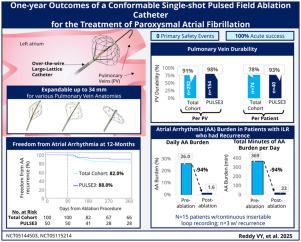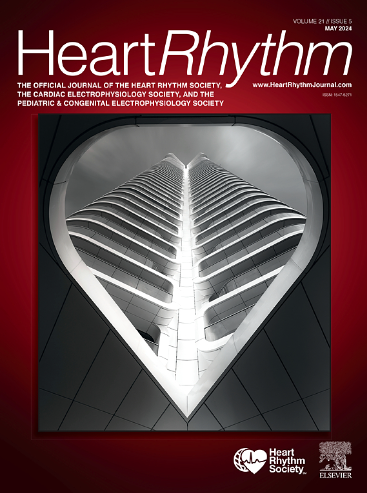One-year outcomes of a conformable single-shot pulsed-field ablation catheter for the treatment of paroxysmal atrial fibrillation
IF 5.7
2区 医学
Q1 CARDIAC & CARDIOVASCULAR SYSTEMS
引用次数: 0
Abstract
Background
Most single-shot pulsed-field ablation (PFA) catheters require extensive repositioning for pulmonary vein isolation (PVI), posing a challenge for obtaining contiguous, durable lesions.
Objective
To determine 1-year outcomes of a single-shot, all-in-one mapping and ablation PFA catheter for treating paroxysmal atrial fibrillation (PAF).
Methods
After PVI with the large-lattice catheter with expandable tip (Sphere-360), follow-up included Holter monitoring at 180 and 365 days and scheduled/symptomatic trans-telephonic monitoring (TTM) or modeled insertable loop recorder (ILR) data. Efficacy outcomes were acute PVI and 12-month freedom from atrial arrhythmias (AA), after 90-day blanking. Optional invasive remapping at 75 days facilitated waveform refinement from PULSE1, PULSE2, to the optimized PULSE3.
Results
At 3 centers, 100 PAF patients underwent PFA with PULSE1 (n = 30), PULSE2 (n = 20), or PULSE3 (n = 50). Procedure, left atrial dwell, and fluoroscopy times were 57.9 ± 20.6, 22.2 ± 11.8 and 6.8 ± 5.7 minutes, respectively. All 395 targeted PVs were acutely isolated, with a transpired PVI time of 11.5 ± 6.0 minutes, using 4.0 ± 1.3 lesions/PV. There were no primary safety events (serious device-related events within 7 days post-PFA). PVI durability with PULSE3 (n = 40) was 98% (per-vein) and 93% (per-patient). One-year freedom from AA recurrence was 82.0% (95% CI:73.0%–88.3%) overall, and 88.0% (95%CI, 75.2%–94.4%) for PULSE3 patients. Of the ILR sub-cohort (n = 15 PULSE3 patients), 3 patients (20%) had recurrences, with an AA burden reduction from 26% (baseline) to 1.6% (post-ablation).
Conclusion
The large lattice PFA catheter was efficient, safe, and effective in treating PAF. The observed high PVI durability translated to clinical effectiveness, even in continuously monitored patients.

一致性单次脉冲场消融导管治疗阵发性心房颤动的1年疗效观察。
背景:大多数单次脉冲场消融(PFA)导管需要广泛重新定位肺静脉隔离(PVI),这对获得连续、持久的病变提出了挑战。目的:确定单次、一体化定位消融PFA导管治疗阵发性心房颤动(PAF)的1年疗效。方法:采用可扩展针尖大点阵导管(Sphere-360)进行PVI后,随访包括180天和365天的Holters和计划/症状跨电话监测(TTM)或建模可插入环记录仪(ILR)数据。在90天的空白后,疗效结果是急性PVI和12个月无心房心律失常(AA)。在75天内,可选择侵入性重新测绘,从PULSE1、PULSE2到优化后的PULSE3的波形细化。结果:在三个中心,100名PAF患者接受了伴有PULSE1 (n= 30)、PULSE2 (n=20)或PULSE3 (n=50)的PFA。手术时间、左房留置时间和透视时间分别为57.9±20.6分钟、22.2±11.8分钟和6.8±5.7分钟。所有395个靶向PV均被急性分离,PVI时间为11.5±6.0分钟,使用4.0±1.3个病变/PV。无主要安全事件(pfa后7天内与器械相关的严重事件)。PULSE3组(n=40)的PVI耐久性分别为98%(每根静脉)和93%(每个患者)。总体而言,一年AA复发无复发率为82.0% (95%CI:73.0-88.3%), PULSE3患者为88.0% (95%CI:75.2-94.4%)。在ILR亚队列(n=15例PULSE3患者)中,3例患者(20%)复发,AA负担从26%(基线)减少到1.6%(消融后)。结论:大点阵PFA导管治疗PAF是一种高效、安全、有效的方法。观察到的高PVI持久性转化为临床有效性,即使在连续监测的患者中也是如此。
本文章由计算机程序翻译,如有差异,请以英文原文为准。
求助全文
约1分钟内获得全文
求助全文
来源期刊

Heart rhythm
医学-心血管系统
CiteScore
10.50
自引率
5.50%
发文量
1465
审稿时长
24 days
期刊介绍:
HeartRhythm, the official Journal of the Heart Rhythm Society and the Cardiac Electrophysiology Society, is a unique journal for fundamental discovery and clinical applicability.
HeartRhythm integrates the entire cardiac electrophysiology (EP) community from basic and clinical academic researchers, private practitioners, engineers, allied professionals, industry, and trainees, all of whom are vital and interdependent members of our EP community.
The Heart Rhythm Society is the international leader in science, education, and advocacy for cardiac arrhythmia professionals and patients, and the primary information resource on heart rhythm disorders. Its mission is to improve the care of patients by promoting research, education, and optimal health care policies and standards.
 求助内容:
求助内容: 应助结果提醒方式:
应助结果提醒方式:


